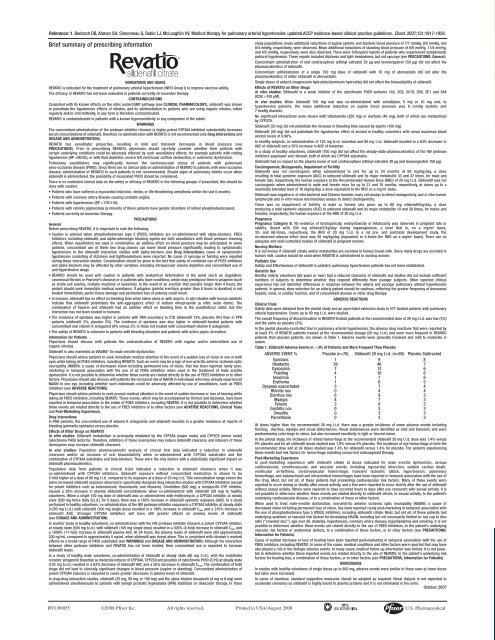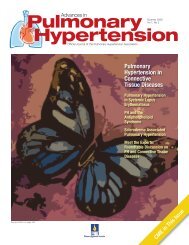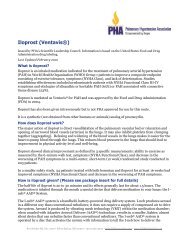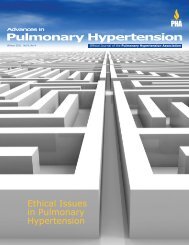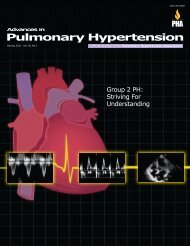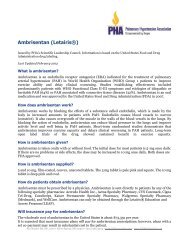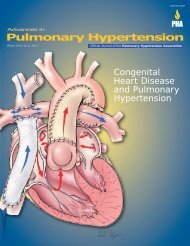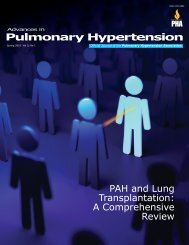Vol 7, No 3 - PHA Online University
Vol 7, No 3 - PHA Online University
Vol 7, No 3 - PHA Online University
Create successful ePaper yourself
Turn your PDF publications into a flip-book with our unique Google optimized e-Paper software.
Reference: 1. Badesch DB, Abman SH, Simonneau G, Rubin LJ, McLaughlin VV. Medical therapy for pulmonary arterial hypertension: updated ACCP evidence-based clinical practice guidelines. Chest. 2007;131:1917-1928.<br />
Brief summary of prescribing information<br />
INDICATIONS AND USAGE<br />
REVATIO is indicated for the treatment of pulmonary arterial hypertension (WHO Group I) to improve exercise ability.<br />
The efficacy of REVATIO has not been evaluated in patients currently on bosentan therapy.<br />
CONTRAINDICATIONS<br />
Consistent with its known effects on the nitric oxide/cGMP pathway (see CLINICAL <strong>PHA</strong>RMACOLOGY), sildenafil was shown<br />
to potentiate the hypotensive effects of nitrates, and its administration to patients who are using organic nitrates, either<br />
regularly and/or intermittently, in any form is therefore contraindicated.<br />
REVATIO is contraindicated in patients with a known hypersensitivity to any component of the tablet.<br />
WARNINGS<br />
The concomitant administration of the protease inhibitor ritonavir (a highly potent CYP3A4 inhibitor) substantially increases<br />
serum concentrations of sildenafil, therefore co-administration with REVATIO is not recommended (see Drug Interactions and<br />
DOSAGE AND ADMINISTRATION).<br />
REVATIO has vasodilator properties, resulting in mild and transient decreases in blood pressure (see<br />
PRECAUTIONS). Prior to prescribing REVATIO, physicians should carefully consider whether their patients with<br />
certain underlying conditions could be adversely affected by such vasodilatory effects, for example patients with resting<br />
hypotension (BP 170/110);<br />
• Patients with retinitis pigmentosa (a minority of these patients have genetic disorders of retinal phosphodiesterases);<br />
• Patients currently on bosentan therapy.<br />
PRECAUTIONS<br />
General<br />
Before prescribing REVATIO, it is important to note the following:<br />
• Caution is advised when phosphodiesterase type 5 (PDE5) inhibitors are co-administered with alpha-blockers. PDE5<br />
inhibitors, including sildenafil, and alpha-adrenergic blocking agents are both vasodilators with blood pressure lowering<br />
effects. When vasodilators are used in combination, an additive effect on blood pressure may be anticipated. In some<br />
patients, concomitant use of these two drug classes can lower blood pressure significantly, leading to symptomatic<br />
hypotension. In the sildenafil interaction studies with alpha-blockers (see Drug Interactions), cases of symptomatic<br />
hypotension consisting of dizziness and lightheadedness were reported. <strong>No</strong> cases of syncope or fainting were reported<br />
during these interaction studies. Consideration should be given to the fact that safety of combined use of PDE5 inhibitors<br />
and alpha-blockers may be affected by other variables, including intravascular volume depletion and concomitant use of<br />
anti-hypertensive drugs.<br />
• REVATIO should be used with caution in patients with anatomical deformation of the penis (such as angulation,<br />
cavernosal fibrosis or Peyronie’s disease) or in patients who have conditions, which may predispose them to priapism (such<br />
as sickle cell anemia, multiple myeloma or leukemia). In the event of an erection that persists longer than 4 hours, the<br />
patient should seek immediate medical assistance. If priapism (painful erections greater than 6 hours in duration) is not<br />
treated immediately, penile tissue damage and permanent loss of potency could result.<br />
• In humans, sildenafil has no effect on bleeding time when taken alone or with aspirin. In vitro studies with human platelets<br />
indicate that sildenafil potentiates the anti-aggregatory effect of sodium nitroprusside (a nitric oxide donor). The<br />
combination of heparin and sildenafil had an additive effect on bleeding time in the anesthetized rabbit, but this<br />
interaction has not been studied in humans.<br />
• The incidence of epistaxis was higher in patients with PAH secondary to CTD (sildenafil 13%, placebo 0%) than in PPH<br />
patients (sildenafil 3%, placebo 2%). The incidence of epistaxis was also higher in sildenafil-treated patients with<br />
concomitant oral vitamin K antagonist (9% versus 2% in those not treated with concomitant vitamin K antagonist).<br />
• The safety of REVATIO is unknown in patients with bleeding disorders and patients with active peptic ulceration.<br />
Information for Patients<br />
Physicians should discuss with patients the contraindication of REVATIO with regular and/or intermittent use of<br />
organic nitrates.<br />
Sildenafil is also marketed as VIAGRA ® for male erectile dysfunction.<br />
Physicians should advise patients to seek immediate medical attention in the event of a sudden loss of vision in one or both<br />
eyes while taking all PDE5 inhibitors, including REVATIO. Such an event may be a sign of non-arteritic anterior ischemic optic<br />
neuropathy (NAION), a cause of decreased vision including permanent loss of vision, that has been reported rarely postmarketing<br />
in temporal association with the use of all PDE5 inhibitors when used in the treatment of male erectile<br />
dysfunction. It is not possible to determine whether these events are related directly to the use of PDE5 inhibitors or to other<br />
factors. Physicians should also discuss with patients the increased risk of NAION in individuals who have already experienced<br />
NAION in one eye, including whether such individuals could be adversely affected by use of vasodilators, such as PDE5<br />
inhibitors (see ADVERSE REACTIONS).<br />
Physicians should advise patients to seek prompt medical attention in the event of sudden decrease or loss of hearing while<br />
taking all PDE5 inhibitors, including REVATIO. These events, which may be accompanied by tinnitus and dizziness, have been<br />
reported in temporal association to the intake of PDE5 inhibitors, including REVATIO. It is not possible to determine whether<br />
these events are related directly to the use of PDE5 inhibitors or to other factors (see ADVERSE REACTIONS, Clinical Trials<br />
and Post-Marketing Experience).<br />
Drug Interactions<br />
In PAH patients, the concomitant use of vitamin K antagonists and sildenafil resulted in a greater incidence of reports of<br />
bleeding (primarily epistaxis) versus placebo.<br />
Effects of Other Drugs on REVATIO<br />
In vitro studies: Sildenafil metabolism is principally mediated by the CYP3A4 (major route) and CYP2C9 (minor route)<br />
cytochrome P450 isoforms. Therefore, inhibitors of these isoenzymes may reduce sildenafil clearance and inducers of these<br />
isoenzymes may increase sildenafil clearance.<br />
In vivo studies: Population pharmacokinetic analysis of clinical trial data indicated a reduction in sildenafil<br />
clearance and/or an increase of oral bioavailability when co-administered with CYP3A4 substrates and the<br />
combination of CYP3A4 substrates and beta-blockers. These were the only factors with a statistically significant impact on<br />
sildenafil pharmacokinetics.<br />
Population data from patients in clinical trials indicated a reduction in sildenafil clearance when it was<br />
co-administered with CYP3A4 inhibitors. Sildenafil exposure without concomitant medication is shown to be<br />
5-fold higher at a dose of 80 mg t.i.d. compared to its exposure at a dose of 20 mg t.i.d. This concentration range covers the<br />
same increased sildenafil exposure observed in specifically-designed drug interaction studies with CYP3A4 inhibitors (except<br />
for potent inhibitors such as ketoconazole, itraconazole, and ritonavir). Cimetidine (800 mg), a nonspecific CYP inhibitor,<br />
caused a 56% increase in plasma sildenafil concentrations when co-administered with sildenafil (50 mg) to healthy<br />
volunteers. When a single 100 mg dose of sildenafil was co-administered with erythromycin, a CYP3A4 inhibitor, at steady<br />
state (500 mg twice daily [b.i.d.] for 5 days), there was a 182% increase in sildenafil systemic exposure (AUC). In a study<br />
performed in healthy volunteers, co-administration of the HIV protease inhibitor saquinavir, a CYP3A4 inhibitor, at steady state<br />
(1200 mg t.i.d.) with sildenafil (100 mg single dose) resulted in a 140% increase in sildenafil C max and a 210% increase in<br />
sildenafil AUC. Stronger CYP3A4 inhibitors will have still greater effects on plasma levels of sildenafil<br />
(see DOSAGE AND ADMINISTRATION).<br />
In another study in healthy volunteers, co-administration with the HIV protease inhibitor ritonavir, a potent CYP3A4 inhibitor,<br />
at steady state (500 mg b.i.d.) with sildenafil (100 mg single dose) resulted in a 300% (4-fold) increase in sildenafil C max and<br />
a 1000% (11-fold) increase in sildenafil plasma AUC. At 24 hours, the plasma levels of sildenafil were still approximately<br />
200 ng/mL, compared to approximately 5 ng/mL when sildenafil was dosed alone. This is consistent with ritonavir's marked<br />
effects on a broad range of P450 substrates (see WARNINGS and DOSAGE AND ADMINISTRATION). Although the interaction<br />
between other protease inhibitors and REVATIO has not been studied, their concomitant use is expected to increase<br />
sildenafil levels.<br />
In a study of healthy male volunteers, co-administration of sildenafil at steady state (80 mg t.i.d.), with the endothelin<br />
receptor antagonist bosentan (a moderate inducer of CYP3A4, CYP2C9 and possibly of cytochrome P450 2C19) at steady state<br />
(125 mg b.i.d.) resulted in a 63% decrease of sildenafil AUC and a 55% decrease in sildenafil C max. The combination of both<br />
drugs did not lead to clinically significant changes in blood pressure (supine or standing). Concomitant administration of<br />
potent CYP3A4 inducers is expected to cause greater decreases in plasma levels of sildenafil.<br />
In drug-drug interaction studies, sildenafil (25 mg, 50 mg, or 100 mg) and the alpha-blocker doxazosin (4 mg or 8 mg) were<br />
administered simultaneously to patients with benign prostatic hyperplasia (BPH) stabilized on doxazosin therapy. In these<br />
study populations, mean additional reductions of supine systolic and diastolic blood pressure of 7/7 mmHg, 9/5 mmHg, and<br />
8/4 mmHg, respectively, were observed. Mean additional reductions of standing blood pressure of 6/6 mmHg, 11/4 mmHg,<br />
and 4/5 mmHg, respectively, were also observed. There were infrequent reports of patients who experienced symptomatic<br />
postural hypotension. These reports included dizziness and light-headedness, but not syncope (see PRECAUTIONS: General).<br />
Concomitant administration of oral contraceptives (ethinyl estradiol 30 µg and levonorgestrel 150 µg) did not affect the<br />
pharmacokinetics of sildenafil.<br />
Concomitant administration of a single 100 mg dose of sildenafil with 10 mg of atorvastatin did not alter the<br />
pharmacokinetics of either sildenafil or atorvastatin.<br />
Single doses of antacid (magnesium hydroxide/aluminum hydroxide) did not affect the bioavailability of sildenafil.<br />
Effects of REVATIO on Other Drugs<br />
In vitro studies: Sildenafil is a weak inhibitor of the cytochrome P450 isoforms 1A2, 2C9, 2C19, 2D6, 2E1 and 3A4<br />
(IC50 >150 µM).<br />
In vivo studies: When sildenafil 100 mg oral was co-administered with amlodipine, 5 mg or 10 mg oral, to<br />
hypertensive patients, the mean additional reduction on supine blood pressure was 8 mmHg systolic and<br />
7 mmHg diastolic.<br />
<strong>No</strong> significant interactions were shown with tolbutamide (250 mg) or warfarin (40 mg), both of which are metabolized<br />
by CYP2C9.<br />
Sildenafil (50 mg) did not potentiate the increase in bleeding time caused by aspirin (150 mg).<br />
Sildenafil (50 mg) did not potentiate the hypotensive effect of alcohol in healthy volunteers with mean maximum blood<br />
alcohol levels of 0.08%.<br />
In healthy subjects, co-administration of 125 mg b.i.d. bosentan and 80 mg t.i.d. sildenafil resulted in a 63% decrease in<br />
AUC of sildenafil and a 50% increase in AUC of bosentan.<br />
In a study of healthy volunteers, sildenafil (100 mg) did not affect the steady-state pharmacokinetics of the HIV protease<br />
inhibitors saquinavir and ritonavir, both of which are CYP3A4 substrates.<br />
Sildenafil had no impact on the plasma levels of oral contraceptives (ethinyl estradiol 30 µg and levonorgestrel 150 µg).<br />
Carcinogenesis, Mutagenesis, Impairment of Fertility<br />
Sildenafil was not carcinogenic when administered to rats for up to 24 months at 60 mg/kg/day, a dose<br />
resulting in total systemic exposure (AUC) to unbound sildenafil and its major metabolite 33 and 37 times, for male and<br />
female rats, respectively, the human exposure at the Recommended Human Dose (RHD) of 20 mg t.i.d. Sildenafil was not<br />
carcinogenic when administered to male and female mice for up to 21 and 18 months, respectively, at doses up to a<br />
maximally tolerated level of 10 mg/kg/day, a dose equivalent to the RHD on a mg/m 2 basis.<br />
Sildenafil was negative in in vitro bacterial and Chinese hamster ovary cell assays to detect mutagenicity, and in vitro human<br />
lymphocyte and in vitro mouse micronucleus assays to detect clastogenicity.<br />
There was no impairment of fertility in male or female rats given up to 60 mg sildenafil/kg/day, a dose<br />
producing a total systemic exposure (AUC) to unbound sildenafil and its major metabolite 19 and 38 times, for males and<br />
females, respectively, the human exposure at the RHD of 20 mg t.i.d.<br />
Pregnancy<br />
Pregnancy Category B. <strong>No</strong> evidence of teratogenicity, embryotoxicity or fetotoxicity was observed in pregnant rats or<br />
rabbits, dosed with 200 mg sildenafil/kg/day during organogenesis, a level that is, on a mg/m 2 basis,<br />
32- and 68-times, respectively, the RHD of 20 mg t.i.d. In a rat pre- and postnatal development study, the<br />
no-observed-adverse-effect dose was 30 mg/kg/day (equivalent to 5-times the RHD on a mg/m 2 basis). There are no<br />
adequate and well-controlled studies of sildenafil in pregnant women.<br />
Nursing Mothers<br />
It is not known if sildenafil citrate and/or metabolites are excreted in human breast milk. Since many drugs are excreted in<br />
human milk, caution should be used when REVATIO is administered to nursing women.<br />
Pediatric Use<br />
Safety and Effectiveness of sildenafil in pediatric pulmonary hypertension patients has not been established.<br />
Geriatric Use<br />
Healthy elderly volunteers (65 years or over) had a reduced clearance of sildenafil, but studies did not include sufficient<br />
numbers of subjects to determine whether they respond differently from younger subjects. Other reported clinical<br />
experience has not identified differences in response between the elderly and younger pulmonary arterial hypertension<br />
patients. In general, dose selection for an elderly patient should be cautious, reflecting the greater frequency of decreased<br />
hepatic, renal, or cardiac function, and of concomitant disease or other drug therapy.<br />
ADVERSE REACTIONS<br />
Clinical Trials<br />
Safety data were obtained from the pivotal study and an open-label extension study in 277 treated patients with pulmonary<br />
arterial hypertension. Doses up to 80 mg t.i.d. were studied.<br />
The overall frequency of discontinuation in REVATIO-treated patients at the recommended dose of 20 mg t.i.d. was low (3%)<br />
and the same as placebo (3%).<br />
In the pivotal placebo-controlled trial in pulmonary arterial hypertension, the adverse drug reactions that were reported by<br />
at least 3% of REVATIO patients treated at the recommended dosage (20 mg t.i.d.) and were more frequent in REVATIO<br />
patients than placebo patients, are shown in Table 1. Adverse events were generally transient and mild to moderate in<br />
nature.<br />
Table 1. Sildenafil Adverse Events in 3% of Patients and More Frequent Than Placebo<br />
ADVERSE EVENT %<br />
Epistaxis<br />
Headache<br />
Dyspepsia<br />
Flushing<br />
Insomnia<br />
Erythema<br />
Dyspnea exacerbated<br />
Rhinitis nos<br />
Diarrhea nos<br />
Myalgia<br />
Pyrexia<br />
Gastritis nos<br />
Sinusitis<br />
Paresthesia<br />
Placebo (n=70) Sildenafil 20 mg t.i.d. (n=69) Placebo Subtracted<br />
1<br />
9<br />
8<br />
39 46<br />
7<br />
741130643000 13<br />
6<br />
10 6<br />
7674976333 6<br />
5<br />
4<br />
4<br />
3<br />
3<br />
3<br />
3<br />
3<br />
3<br />
At doses higher than the recommended 20 mg t.i.d. there was a greater incidence of some adverse events including<br />
flushing, diarrhea, myalgia and visual disturbances. Visual disturbances were identified as mild and transient, and were<br />
predominately color-tinge to vision, but also increased sensitivity to light or blurred vision.<br />
In the pivotal study, the incidence of retinal hemorrhage at the recommended sildenafil 20 mg t.i.d. dose was 1.4% versus<br />
0% placebo and for all sildenafil doses studied was 1.9% versus 0% placebo. The incidence of eye hemorrhage at both the<br />
recommended dose and at all doses studied was 1.4% for sildenafil versus 1.4% for placebo. The patients experiencing<br />
these events had risk factors for hemorrhage including concurrent anticoagulant therapy.<br />
Post-Marketing Experience<br />
In post-marketing experience with sildenafil citrate at doses indicated for male erectile dysfunction, serious<br />
cardiovascular, cerebrovascular, and vascular events, including myocardial infarction, sudden cardiac death,<br />
ventricular arrhythmia, cerebrovascular hemorrhage, transient ischemic attack, hypertension, pulmonary<br />
hemorrhage, and subarachnoid and intracerebral hemorrhages have been reported in temporal association with the use of<br />
the drug. Most, but not all, of these patients had preexisting cardiovascular risk factors. Many of these events were<br />
reported to occur during or shortly after sexual activity, and a few were reported to occur shortly after the use of sildenafil<br />
without sexual activity. Others were reported to have occurred hours to days after use concurent with sexual activity. It is<br />
not possible to determine whether these events are related directly to sildenafil citrate, to sexual activity, to the patient’s<br />
underlying cardiovascular disease, or to a combination of these or other factors.<br />
When used to treat male-erectile dysfunction, non-arteritic anterior ischemic optic neuropathy (NAION), a cause of<br />
decreased vision including permanent loss of vision, has been reported rarely post-marketing in temporal association with<br />
the use of phosphodiesterase type 5 (PDE5) inhibitors, including sildenafil citrate. Most, but not all, of these patients had<br />
underlying anatomic or vascular risk factors for developing NAION, including but not necessarily limited to: low cup to disc<br />
ratio (“crowded disc”), age over 50, diabetes, hypertension, coronary artery disease, hyperlipidemia and smoking. It is not<br />
possible to determine whether these events are related directly to the use of PDE5 inhibitors, to the patient’s underlying<br />
vascular risk factors or anatomical defects, to a combination of these factors, or to other factors (see PRECAUTIONS/<br />
Information for Patients).<br />
Cases of sudden decrease or loss of hearing have been reported post-marketing in temporal association with the use of<br />
PDE5 inhibitors, including REVATIO. In some of the cases, medical conditions and other factors were reported that may have<br />
also played a role in the otologic adverse events. In many cases, medical follow-up information was limited. It is not possible<br />
to determine whether these reported events are related directly to the use of REVATIO, to the patient’s underlying risk<br />
factors for hearing loss, a combination of these factors, or to other factors (see PRECAUTIONS, Information for Patients).<br />
OVERDOSAGE<br />
In studies with healthy volunteers of single doses up to 800 mg, adverse events were similar to those seen at lower doses<br />
but rates were increased.<br />
In cases of overdose, standard supportive measures should be adopted as required. Renal dialysis is not expected to<br />
accelerate clearance as sildenafil is highly bound to plasma proteins and it is not eliminated in the urine.<br />
October 2007<br />
RVU00055 ©2008 Pfizer Inc. All rights reserved. Printed in USA/August 2008<br />
U.S. Pharmaceutical


